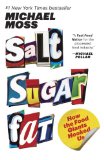Summary | Excerpt | Reviews | Beyond the Book | Readalikes | Genres & Themes | Author Bio

Critics' Opinion:
Readers' Opinion:
First Published:
Feb 2013, 480 pages
Paperback:
Feb 2014, 480 pages
 Book Reviewed by:
Book Reviewed by:
Poornima Apte
Buy This Book
Chapter One
"Exploiting the Biology of the Child"
The first thing to know about sugar is this: Our bodies are hard-wired for sweets.
Forget what we learned in school from that old diagram called the tongue map, the one that says our five main tastes are detected by five distinct parts of the tongue. That the back has a big zone for blasts of bitter, the sides grab the sour and the salty, and the tip of the tongue has that one single spot for sweet. The tongue map is wrong. As researchers would discover in the 1970s, its creators misinterpreted the work of a German graduate student that was published in 1901; his experiments showed only that we might taste a little more sweetness on the tip of the tongue. In truth, the entire mouth goes crazy for sugar, including the upper reaches known as the palate. There are special receptors for sweetness in every one of the mouth's ten thousand taste buds, and they are all hooked up, one way or another, to the parts of the brain known as the pleasure zones, where we get rewarded for stoking our bodies with energy. But our zeal doesn't stop there. Scientists are now finding taste receptors that light up for sugar all the way down our esophagus to our stomach and pancreas, and they appear to be intricately tied to our appetites.
The second thing to know about sugar: Food manufacturers are well aware of the tongue map folly, along with a whole lot more about why we crave sweets. They have on staff cadres of scientists who specialize in the senses, and the companies use their knowledge to put sugar to work for them in countless ways. Sugar not only makes the taste of food and drink irresistible. The industry has learned that it can also be used to pull off a string of manufacturing miracles, from donuts that fry up bigger to bread that won't go stale to cereal that is toasty-brown and fluffy. All of this has made sugar a go-to ingredient in processed foods. On average, we consume 71 pounds of caloric sweeteners each year. That's 22 teaspoons of sugar, per person, per day. The amount is almost equally split three ways, with the sugar derived from sugar cane, sugar beets, and the group of corn sweeteners that includes high-fructose corn syrup (with a little honey and syrup thrown into the mix).
That we love, and crave, sugar is hardly news. Whole books have been devoted to its romp through history, in which people overcame geography, strife, and overwhelming technical hurdles to feed their insatiable habit. The highlights start with Christopher Columbus, who brought sugar cane along on his second voyage to the New World, where it was planted in Spanish Santo Domingo, was eventually worked into granulated sugar by enslaved Africans, and, starting in 1516, was shipped back to Europe to meet the continent's surging appetite for the stuff. The next notable development came in 1807 when a British naval blockade of France cut off easy access to sugar cane crops, and entrepreneurs, racing to meet demand, figured out how to extract sugar from beets, which could be grown easily in temperate Europe. Cane and beets remained the two main sources of sugar until the 1970s, when rising prices spurred the invention of high-fructose corn syrup, which had two attributes that were attractive to the soda industry. One, it was cheap, effectively subsidized by the federal price supports for corn; and two, it was liquid, which meant that it could be pumped directly into food and drink. Over the next thirty years, our consumption of sugar-sweetened soda more than doubled to 40 gallons a year per person, and while this has tapered off since then, hitting 32 gallons in 2011, there has been a commensurate surge in other sweet drinks, like teas, sports ades, vitamin waters, and energy drinks. Their yearly consumption has nearly doubled in the past decade to 14 gallons a person.
Far less well known than the history of sugar, however, is the intense research that scientists have conducted into its allure, the biology and psychology of why we find it so irresistible.
Excerpted from Salt Sugar Fat by Michael Moss. Copyright © 2013 by Michael Moss. Excerpted by permission of Random House, a division of Random House, Inc. All rights reserved. No part of this excerpt may be reproduced or reprinted without permission in writing from the publisher.





The House on Biscayne Bay
by Chanel Cleeton
As death stalks a gothic mansion in Miami, the lives of two women intertwine as the past and present collide.

The Flower Sisters
by Michelle Collins Anderson
From the new Fannie Flagg of the Ozarks, a richly-woven story of family, forgiveness, and reinvention.

The Funeral Cryer by Wenyan Lu
Debut novelist Wenyan Lu brings us this witty yet profound story about one woman's midlife reawakening in contemporary rural China.
Your guide toexceptional books
BookBrowse seeks out and recommends the best in contemporary fiction and nonfiction—books that not only engage and entertain but also deepen our understanding of ourselves and the world around us.